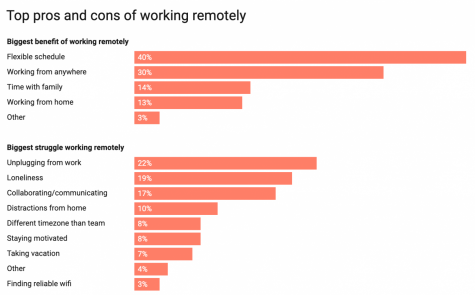At Home or in the Office?
What are the pros and cons of the “new normal” for the employed?
April 28, 2020
It has been about two months since the ISB has made a shift from regular classes to online learning. As we do not know when the pandemic of COVID-19 will end, ISB will be following the government policy to close the school until the end of May, at least. This transition from daily commute to online connection is not unique to ISB but is affecting schools and workplaces around the world. In the US, the percentage of workers who work remotely at least half the time was 18% in 2018. Now, 52% of workers work remotely due to the spread of COVID-19. Can this change be considered a positive change or is it rather destructive? Here are some benefits and demerits of shifts towards remote working
- Pros: The benefits brought by the flexible nature of remote work
By working remotely, the workers can be more flexible with their working time. Remote work eliminates the need for a lengthy commute, saving a lot of time for workers. Since it is difficult to keep track of the working hours in remote work, it is likely that the workers will be rewarded based on their achievement rather than their time spent on work. This means that as long as the work is completed, the workers can start or end their work whenever they like and have as much break as they want. The flexibility not only increases the productivity of the workers but also encourages women empowerment. Out of several hindrances, one of the disadvantages associated with women’s promotion at work is that the women who chose to have a child have to quit her job for about a year due to maternity leave. Moreover, 43% of women leave their job after they give birth to a child since many women find their transition back to their workplace difficult. Remote work allows women to work at home while taking care of her child, so she can make a smooth shift to her regular work after she finishes her maternity leave. As remote work has the prospect of lessening the gender pay gap, we can say that the coronavirus has pushed gender equality forward by a step.
- Cons: effects on health
When It comes to health, remote work is a double-edged sword. Some remote-workers may enjoy the freedom from managers’ supervision and autonomy over your schedule. However, this is not always the case. Some people might experience mental health issues associated with isolation. As shown in the graph, the second-largest struggle for remote workers is the lack of social connection. 
Although remote workers may have communications with their colleagues through email or video call, their relationships in workplaces tend to be businesslike: it is difficult for them to expand their relationships beyond what is necessary for their work. Virtual learners at ISB may have experienced this. The face-to-face interactions of students at ISB have decreased significantly, and some are starting to get anxious. Here is a surprising fact; the health problems brought by chronic loneliness are equivalent to that of smoking 15 cigarettes a day. Mental health is one of the concerns that we face as the world makes the shift towards remote work.
In addition to mental health, the sleeping habit of workers is being affected as well. Although some may think that since remote work removes the need for the workers to wake up early in the morning or stay up late at night due to their time being taken away by commute, remote works typically get more sleep than those who work at offices, the reality is contrary to this assumption. According to a survey by Amerisleep, 40% of remote workers which is higher than 35%, the average for Americans, sleep for 8 hours a day, the recommended hour of sleep for adults. Due to the competitive nature of remote workers, they tend to set demanding deadlines for themselves. Insufficient sleeping hours will cause health problems such as weak immunity, high stress levels, and increased risk of lifestyle-related disease. All of this may result in a loss of productivity.
If you are a student, you might be working at home in the future. Now as there are many choices available for workers, it is very important that you choose the work style that fits the best for you. To take freedom or to take human connection – it is your choice.
